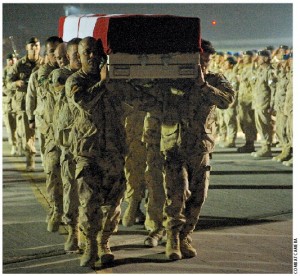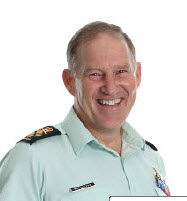 Canadian Forces’ Chief of Defence Staff, General Walter Natynczyk, grew up in Winnipeg and had jobs as a paperboy and burger flipper before joining the military in 1975 and rising through the ranks to the top job, which he did in 2008. For the past four years, he has skipped Christmas with his family — all three of his children are in the Canadian Forces as well — to spend it in Afghanistan with his troops, often taking politicians and diplomats along for the ride. He lives in Ottawa, and, while his heart remains with the Winnipeg Jets (the team now playing as the Phoenix Coyotes in Arizona), he cheers for the Sens from his post in the nation’s capital. Diplomat’s editor, Jennifer Campbell, sat down with him late last fall — just before the federal government announced its plans to extend Canada’s military engagement in Afghanistan in a non-combat role.
Canadian Forces’ Chief of Defence Staff, General Walter Natynczyk, grew up in Winnipeg and had jobs as a paperboy and burger flipper before joining the military in 1975 and rising through the ranks to the top job, which he did in 2008. For the past four years, he has skipped Christmas with his family — all three of his children are in the Canadian Forces as well — to spend it in Afghanistan with his troops, often taking politicians and diplomats along for the ride. He lives in Ottawa, and, while his heart remains with the Winnipeg Jets (the team now playing as the Phoenix Coyotes in Arizona), he cheers for the Sens from his post in the nation’s capital. Diplomat’s editor, Jennifer Campbell, sat down with him late last fall — just before the federal government announced its plans to extend Canada’s military engagement in Afghanistan in a non-combat role.
Diplomat Magazine: Would you speak to Canada’s engagement in Afghanistan?
Walter Natynczyk: I’ve just come back from Afghanistan. This was probably my 12th visit in about four years and what our men and women are doing is absolutely fascinating. I couldn’t be more proud. This year, we’ve seen the uplift [“surge”] of U.S. forces in the region and it’s having a significant impact on what’s happening on the ground. While even my own soldiers are asking about next summer, my [priority] is on making progress tomorrow, next week, and next month.
The [people on the ground] have done so much since my last visit in July. I could see the qualitative improvement in the Afghan national army. I could see [the results] of the uplift in the forces. When we clear an area, we have sufficient troop density to stay.
In the past, the Afghans’ great concern, after we’ve gone through a town, was that they were left to intimidation of the Taliban thugs — that there was no one there to protect them from the intimidation.
Now, for the first time, the troop allocations by NATO are sufficient to have an enduring presence. Two years ago, we had about 3,000 Canadians in our operations base in Kandahar Province, which is a huge area. Today, there are 12,000 U.S. soldiers alongside us.
Perhaps even more significant is that four years ago, in 2006, when we were engaged in Operation Medusa, we had about two platoons of Afghan army, about 50 people. Today, we’re mentoring about 4,500 Afghan soldiers in Kandahar province. That’s having a significant effect, not only in terms of their very presence but also in the trust that the Afghan population have in their own people, whether police or army.
We’ve found that in all operations where we weren’t speaking the native language we didn’t know what “normal” looks like. The Afghan army does, the Afghan army police do, and the villagers and farmers and the tribal elders do. But for those village elders to provide the information to the Afghan Army and police, they have to feel secure.
It was on this [most recent] trip, in eastern Panjwaye, that we saw this change because, for the first time, we moved into a place and the Afghan army stayed. We saw the Afghan population sharing information. We’re hearing anecdotally that they’re providing less support to the Taliban, less shelter, food, medical supplies.
These are small signs which we haven’t seen before. These signs connected back to what we saw when we visited Kabul. The qualitative improvements are significant. Only 10 percent of Afghans are literate but, in November, 30,000 people are engaged with or have completed a literacy program in the Afghan army. They projected [that this number] would rise in December to 40,000 and by next spring to 100,000. The [conclusion] I’ve heard, and it’s absolutely true, is that education is a force multiplier.
Imagine this vignette, which occurred in Afghanistan before we got there. In one region, there was a company of really well-trained Afghan army soldiers. They had gone through all the training and had good leadership. But they got ambushed and a number of soldiers were wounded. Nobody in the company could read. No one could read a map and describe on the radio where they were, using number grid coordinates. No one could call for artillery fire. So literacy is a force multiplier. The training we’re providing in Kabul and Kandahar is having a significant effect.
[Regarding future engagement], I’ve said to soldiers and to the leadership of the Canadian Forces that we’ll be true to the parliamentary motion which says that the Canadian forces will leave Kandahar province in the summer of 2011 and that this will end our [combat] mission. We are working with our NATO allies for a seamless transition. This is like a relay race where we’re sprinting to the finish in order to transfer the baton to the people who are going to keep on running.
Looking at the regions that we’re in, these locations are key. As goes Kandahar, so goes the country. We can’t let up in terms of our focus on the mission. I’ve got great confidence we will continue to build the security forces, to partner with them in the towns that they’re in — and, similarly, to work with Foreign Affairs and CIDA on building governance.
We’ve seen the leadership in Daman district and Panjwaye district grow as we’re able to assist the Afghans with development projects that affect the lives of their constituents. If you keep complaining that your district leader can’t provide anything, you’re going to go to the power broker — someone who can accommodate your needs. We’re seeing now that these district governors are showing results to their constituents.

DM: The former Afghan ambassador to Canada — Jawed Ludin — repeatedly asked Canada to stay on to train Afghan police and armed forces. Do you agree that this is important?
WN: Absolutely. It’s not only what happens out there in the field. It’s what happens in training facilities scattered across the country. We’ve sponsored the junior officers’ staff college; there’s also a senior officers’ staff college. We have four Afghan cadets attending Royal Military College here in Canada. I’ve met with them and they’re doing exceptionally well. I would say that, though this is the end of the military mission, this is not the end of Canada’s missions, which still involve CIDA, Foreign Affairs, and through them, sponsorship of Afghan police training. There are other ways and means to provide support. We’re working with our government partners to determine how you continue all these other training programs.
DM: Has the engagement in Afghanistan — the first time in decades our soldiers have faced active combat as opposed to peacekeeping — changed the Canadian Forces?
WN: I would say that the Canadian Forces has a new normal. Soldiers, sailors, airmen and women, special forces — all have great confidence in their skills and their abilities have been proven in a hard operational field.
We’ve been in awful situations before. Bosnia, 15 years ago, was a combat theatre. But our UN mandate was to provide support for humanitarian supplies. We weren’t equipped to be able to stop the violence. We were spectators to a violent action, unable, through mandate or equipment, to intervene. We’ve had a lot of issues with our own people because of that inability.
Rwanda was the same kind of environment. There are three levels of peacekeeping: peacekeeping, peace-enforcement and peace-building, which is what we are now doing. [It’s] counter-insurgency, counter-terrorism, governance, development, training, all at the same time and all combined with nation-building.
[In Afghanistan,] we’re doing various pieces of the peace-keeping and the peace-building missions. If you’re in one of the quieter provinces, in some cases, you’re peace-keeping because you’re monitoring what’s happening in a fairly quiet area. In other areas, it’s pretty tense.
To a degree, it’s peace-enforcement with knowledge of what’s going on and trying to keep a lid on it. We are in a bad neighbourhood. [The job] is peace-building from the base up. [Take] the Daman district and the model village where we had to go about 18 months ago. There had been no ISAF (International Security Assistance Force) in there at all. We went in with a good district governor, providing a security blanket, partnering with the Afghan police and bringing in projects through CIDA and DFAIT and empowering the governor so he had the respect of the village elders.
Two years ago, when we rolled in, there wasn’t a single school. Last year, there were four. Today there are 26. We’re doing the same thing now in Panjwaye, a tougher neighbourhood. The difference is that they see what’s happening next door and they like it. Now we have more Afghan police and army. When we move in to an area, we stay. The context is changing.
DM: Can you tell me a story that’s stuck with you?
WN: I have a lot and a lot of them are sad. I just had a great doc come in — Ray Wiss is his name — and he’s written these two books [FOB Doc and A Line in the Sand]. He’s the forward operating base doctor. As I look at the pictures (in these books), the memories come back. I have so many memories of seeing soldiers, sailors, airmen and women in various circumstances. I have visited members in hospital when they’re injured and then seeing them many years later. I ask myself: ‘As an institution, are we taking care of that person and his or her family?’
I see how we’ve evolved as a military, as an army, navy, air force. In 2006, we had light-armoured vehicles in Operation Medusa; today, our force has, if not the best, among the best, equipment of any contingent in Afghanistan. [Operation Medusa was a Canadian-led offensive that began in September 2006 in the Taliban stronghold Panjwaye west of Kandahar City. Four Canadian soldiers were killed.]
When I think of the armoured heavy logistics truck [the Mercedes Benz vehicles that replaced the Canadian army’s aging previous-generation models and which are designed to protect against improvised explosive devices and ballistic threats] I think about a private — she stood about 5’2” — getting into a 16-tonne truck, driving in a convoy. A suicide bomb truck came up beside her. The American helicopters were providing escort for them. They called her and said a suspicious vehicle was coming up on her left-hand side. She veered to the right, the car blew up and she was fine. She was fine because of the great truck she was driving and because of the partnership with the folks in that helicopter.
Or, I talk to the soldiers and they show me pictures of Canadian tanks that rolled in to support an American company that was ambushed. Three soldiers killed, many wounded, and this time it was the Canadians who rolled in with their new Leopard tanks and their light-armoured vehicles to support an American company.
In both cases, the stories were told to me with pride — because they had the equipment and the skills to persevere in difficult circumstances.
Or on one visit, I’d just done a town hall meeting when the alarm went up. Suicide car bomb. A suicide bomber had walked into a nearby town and all eight casualties were rolling in, from young children to elderly citizens. They rolled into the medical clinic and these guys were doing a great job.
Or last Christmas Eve, I was standing on the turret of a tank. It was midnight. And there are two sergeants who had volunteered to do duty so the young privates and corporals could sleep on Christmas eve. I had (Secretary of State for Sport) Gary Lunn, (MP) Laurie Hawn and U.S. Ambassador David Jacobson with me and Minister Lunn was giving out Olympic mittens. So you have these two wonderful warriors getting their mittens.
That same evening, I was brushing my teeth — in this makeshift bathroom —- with (Calgary Herald reporter) Michelle Lang. She gave us a good hard interview on Boxing Day and then I left. She had accompanied me on Christmas Day. We [visited] five operating bases on Christmas day. Three were Canadian bases and two were American bases where there were a significant number of Canadians. [Four days later, Michelle Lang was killed when the armoured vehicle she was riding in struck a roadside bomb. She was the first Canadian journalist to be killed in Afghanistan. Four Canadian soldiers were killed in the same blast.]
DM: Describe a day when you lose a soldier.
WN: There’s no worse day for me. There’s no worse duty anyone has than calling a grieving mom, a grieving spouse, a grieving father and then standing in Trenton [waiting for arrival of the casket.] But we have to all be strong because we have a duty on behalf of Canada to provide support to the family, to show that Canada shares in the family’s grief.
At the same time, we need to provide support to these families on the worst possible days of their lives. So while there’s grief, we have to put our game face on. I am just so proud of all the Canadians who line the highways, whether it be the 401 or the road from the airport to Val Cartier or the road from the airport to Steele Barracks in Edmonton. Or any of the small communities coast to coast where [people pay tribute]. It makes you proud to be Canadian.





